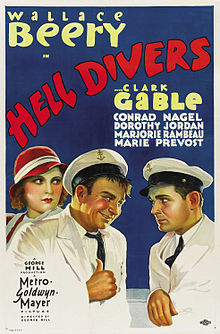
Wallace Fitzgerald Beery was an American film and stage actor. He is best known for his portrayal of Bill in Min and Bill (1930) opposite Marie Dressler, as General Director Preysing in Grand Hotel (1932), as Long John Silver in Treasure Island (1934), as Pancho Villa in Viva Villa! (1934), and his title role in The Champ (1931), for which he won the Academy Award for Best Actor. Beery appeared in some 250 films during a 36-year career. His contract with Metro-Goldwyn-Mayer stipulated in 1932 that he would be paid $1 more than any other contract player at the studio. This made Beery the highest-paid film actor in the world during the early 1930s. He was the brother of actor Noah Beery and uncle of actor Noah Beery Jr.

USS Saratoga (CV-3) was a Lexington-class aircraft carrier built for the United States Navy during the 1920s. Originally designed as a battlecruiser, she was converted into one of the Navy's first aircraft carriers during construction to comply with the Washington Naval Treaty of 1922. The ship entered service in 1928 and was assigned to the Pacific Fleet for her entire career. Saratoga and her sister ship, Lexington, were used to develop and refine carrier tactics in a series of annual exercises before World War II. On more than one occasion these exercises included successful surprise attacks on Pearl Harbor, Hawaii. She was one of three prewar US fleet aircraft carriers, along with Enterprise and Ranger, to serve throughout World War II.

The Curtiss Falcon was a family of military biplane aircraft built by the American aircraft manufacturer Curtiss Aeroplane and Motor Company during the 1920s. Most saw service as part of the United States Army Air Corps as observation aircraft with the designations O-1 and O-11, or as the attack aircraft designated the A-3 Falcon.

The Douglas SBD Dauntless is a World War II American naval scout plane and dive bomber that was manufactured by Douglas Aircraft from 1940 through 1944. The SBD was the United States Navy's main carrier-based scout/dive bomber from mid-1940 through mid-1944. The SBD was also flown by the United States Marine Corps, both from land air bases and aircraft carriers. The SBD is best remembered as the bomber that delivered the fatal blows to the Japanese carriers at the Battle of Midway in June 1942. The type earned its nickname "Slow But Deadly" during this period, along with a rarely-used accompanying nickname of "Furious D."

The Curtiss SB2C Helldiver is a dive bomber developed by Curtiss-Wright during World War II. As a carrier-based bomber with the United States Navy (USN), in Pacific theaters, it supplemented and replaced the Douglas SBD Dauntless. A few survivors are extant.
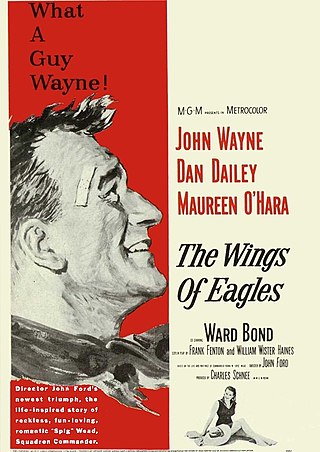
The Wings of Eagles is a 1957 American Metrocolor film starring John Wayne, Dan Dailey and Maureen O'Hara, based on the life of Frank "Spig" Wead and the history of U.S. Naval aviation from its inception through World War II. The film is a tribute to Wead from his friend, director John Ford, and was based on Wead's "We Plaster the Japs", published in a 1944 issue of The American Magazine.

Task Force is a 1949 American war film filmed in black-and-white with some Technicolor sequences about the development of U.S. aircraft carriers from USS Langley (CV-1) to USS Franklin (CV-13). Although Robert Montgomery was originally considered for the leading role, the film stars Gary Cooper, Jane Wyatt, Walter Brennan, Wayne Morris, Julie London and Jack Holt. Task Force was the only film Gary Cooper and Jane Wyatt made together, and was the last of the eight films Cooper and Walter Brennan made together. The U.S. Navy provided complete support in not only lending naval vessels and facilities, but also allowed the use of archival footage of the development of naval air power.
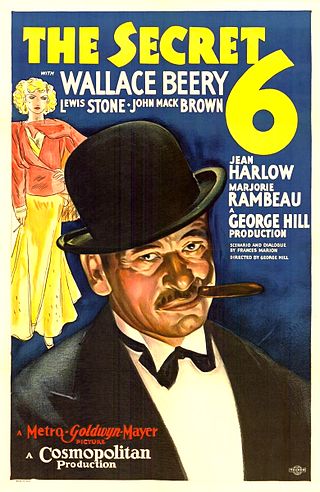
The Secret Six is a 1931 American pre-Code crime film starring Wallace Beery as "Slaughterhouse Scorpio", a character very loosely based on Al Capone, and featuring Lewis Stone, John Mack Brown, Jean Harlow, Clark Gable, Marjorie Rambeau and Ralph Bellamy. The film was written by Frances Marion and directed by George W. Hill for MGM.

Wing and a Prayer, The Story of Carrier X is a black-and-white 1944 war film about the heroic crew of an American aircraft carrier in the desperate early days of World War II in the Pacific theater, directed by Henry Hathaway and starring Don Ameche, Dana Andrews and William Eythe. Although arguably a classic propaganda movie, it was appreciated for its realistic portrayal and was nominated for the 1944 Academy Award for Best Original Screenplay.
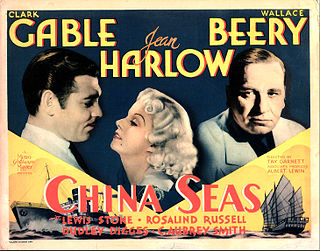
China Seas is a 1935 American adventure film starring Clark Gable as a brave sea captain, Jean Harlow as his brassy paramour, and Wallace Beery as a suspect character. The oceangoing epic also features Rosalind Russell, Lewis Stone, Akim Tamiroff, and Hattie McDaniel, while humorist Robert Benchley memorably portrays a character reeling drunk from one end of the film to the other.

Body and Soul (1931) is an American Pre-Code action drama film directed by Alfred Santell and starring Charles Farrell, Elissa Landi, Humphrey Bogart, and Myrna Loy. The story, adapted from the stage play Squadrons by Elliott White Springs and A.E. Thomas, depicts Royal Air Force pilots in World War I.
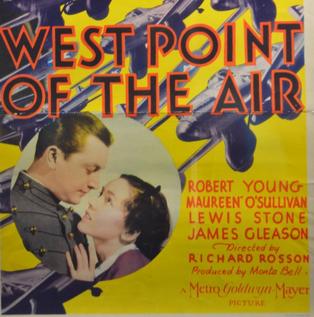
West Point of the Air is a 1935 American drama film directed by Richard Rosson and starring Wallace Beery, Robert Young, Lewis Stone, Maureen O'Sullivan, Rosalind Russell, and Robert Taylor. The screenplay concerns pilot training in the U.S. Army Air Corps in the early 1930s.

This Man's Navy is a 1945 World War II film about U.S. Navy blimps directed by William A. Wellman and starring Wallace Beery, Tom Drake, Jan Clayton and James Gleason. The supporting cast features Selena Royle and Beery's brother Noah Beery Sr., and presents a rare opportunity to see both Beery brothers work together in their later years. The picture is also one of the very few films, other than training films, to depict U.S. Navy airship operations.
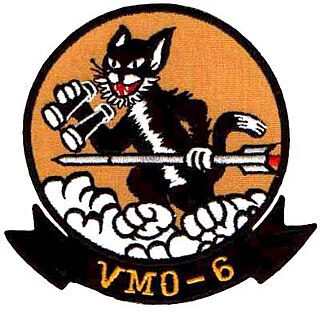
Marine Observation Squadron 6 (VMO-6) was an observation squadron of the United States Marine Corps which saw extensive action during the Battle of Okinawa in World War II and the Korean and Vietnam Wars. The squadron was the first Marine Corps helicopter squadron to participate in combat operations when it participated in the Battle of Pusan Perimeter in August 1950. The squadron was decommissioned on 1 January 1977.

Dive Bomber is a 1941 American aviation drama film directed by Michael Curtiz, and starring Errol Flynn, Fred MacMurray and Alexis Smith. It was produced and distributed by Warner Brothers. The film is notable for both its Technicolor photography of pre-World War II United States Navy aircraft and as a historical document of the U.S. in 1941. This includes the aircraft carrier USS Enterprise, one of the best-known U.S. warships of World War II.
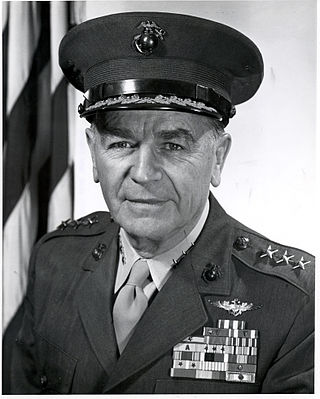
John Calvin Munn was the 8th Assistant Commandant of the Marine Corps and United States Naval Aviator. He served for 37 years in the United States Marine Corps.

Flight Command is a 1940 American U.S. Navy film from MGM, produced by Frank Borzage and directed by J. Walter Ruben and Frank Borzage (uncredited), starring Robert Taylor, Ruth Hussey, and Walter Pidgeon. It has the distinction of often being credited as the first Hollywood film glorifying the American military to be released after the outbreak of World War II in Europe, a year before the U.S. entered the conflict.

Devil Dogs of the Air is a 1935 Warner Bros. film, directed by Lloyd Bacon and starring James Cagney and Pat O'Brien, playing similar roles as close friends after making their debut as a "buddy team" in Here Comes the Navy. Devil Dogs of the Air was the second of nine features that James Cagney and Pat O'Brien made together. The film's storyline was adapted from a novel by John Monk Saunders.

The Flying Fleet is a 1929 synchronized sound romantic drama film directed by George W. Hill and starring Ramon Novarro, Ralph Graves, and Anita Page. While the film has no audible dialog, it was released with a synchronized musical score with sound effects using both the sound-on-disc and sound-on-film process. Two United States Navy officers are rivals for the love of the same woman.

VA-54 was an early and long-lived Attack Squadron of the U.S. Navy, operating under many designations during its 20-year life. It was established as Scouting Squadron VS-2B on 3 July 1928, and redesignated as VS-3 on 1 July 1937, and as Bombing Squadron VB-4 on 1 March 1943. It was redesignated as VB-5 on 15 July of that same year, and as Attack Squadron VA-5A on 15 November 1946. Finally, it was redesignated as VA-54 on 15 November 1946. VA-54 was disestablished on 1 December 1949. The squadron's insignia varied over its lifetime, depicting in turn a bird dog, a devil, and finally a bomb and five playing cards. Its nickname is unknown. It was the first squadron to be designated VA-54, a second VA-54 was redesignated from VF-54 on 15 June 1956 and disestablished on 1 April 1958.
